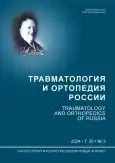Дистракция продольно расщепленных фрагментов по методу Илизарова: серия клинических случаев лечения частичных костных дефектов
- Авторы: Ванденбулке Ф.1,2, Малаголи Э.3, Кириенко А.3
-
Учреждения:
- Humanitas Clinical and Research Center – IRCCS
- Humanitas University, Department of Biomedical Sciences
- Humanitas Clinical and Research Center — IRCCS
- Выпуск: Том 30, № 3 (2024)
- Страницы: 95-104
- Раздел: Случаи из практики
- URL: https://journal-vniispk.ru/2311-2905/article/view/268333
- DOI: https://doi.org/10.17816/2311-2905-17492
- ID: 268333
Цитировать
Полный текст
Аннотация
Актуальность. Метод Илизарова — это общепризнанный метод лечения тяжелых повреждений скелета, позволяющий комплексно восстанавливать как костные, так и мягкотканные компоненты. Несмотря на то, что удлинение и несвободная трансплантация кости (транспорт кости) являются широко известными техниками, дистракция продольно расщепленного фрагмента по-прежнему применяется крайне редко.
Цель исследования — описать серию клинических случаев с участием пациентов, оперированных методом дистракции продольно расщепленного фрагмента.
Материал и методы. Представлена серия наблюдений пяти пациентов, которым в период с января 2006 по декабрь 2022 г. была выполнена дистракция продольно расщепленного фрагмента по методу Илизарова. Клиническая информация была получена из историй болезни, все оперативные вмешательства были задокументированы. Послеоперационное обследование проводилось методом рентгенографии.
Результаты. Серия случаев демонстрирует успешное применение данной методики для реконструкции ограниченных костных дефектов, возникших в результате травмы или остеомиелита. В исследование были включены пять пациентов (4 мужчины и 1 женщина), которым была выполнена операция через 4,8–34,0 мес. после травмы по поводу ограниченного дефекта проксимального отдела большеберцовой кости длиной от 4 до 8 см. Дистракция проводилась в разных направлениях вдоль сагиттальной и продольной осей. Время внешней фиксации варьировалось от 3,5 до 4,8 мес., индекс внешней фиксации — от 0,49 до 1,22. Функциональный показатель ASAMI (Association for the Study and Application of the Methods of Ilizarov) на контрольном осмотре был отличным у всех пяти пациентов. Оценка костной ткани по ASAMI показала отличные результаты у всех пациентов, за исключением одного пациента с остаточным эквинусом (хороший результат). Других осложнений не наблюдалось.
Заключение. Метод Илизарова обеспечивает минимально инвазивный и комплексный подход к устранению ограниченных костных дефектов, воздействуя одновременно на костные и мягкотканные компоненты. Благодаря продольному расщеплению при транспортировке фрагмента и дистракционному остеогенезу этот метод способствует регенерации костей и мягких тканей и помогает избежать объемного костного дефекта и более сложной сегментарной транспортировки кости. Более того, возрастает роль поперечного транспорта кортикального слоя большеберцовой кости при лечении заболеваний периферических артерий.
Ключевые слова
Полный текст
Открыть статью на сайте журналаОб авторах
Филиппо Ванденбулке
Humanitas Clinical and Research Center – IRCCS; Humanitas University, Department of Biomedical Sciences
Автор, ответственный за переписку.
Email: filippo@vandenbulcke.org
ORCID iD: 0000-0002-4603-659X
MD
Италия, Rozzano (MI); Pieve Emanuele (MI)Эмилиано Малаголи
Humanitas Clinical and Research Center — IRCCS
Email: emiliano.malagoli@gmail.com
ORCID iD: 0000-0003-0239-080X
MD
Италия, Rozzano (MI)Александр Кириенко
Humanitas Clinical and Research Center — IRCCS
Email: alexander@kirienko.com
ORCID iD: 0000-0003-0107-3423
MD
Италия, Rozzano (MI)Список литературы
- Mauffrey C., Barlow B.T., Smith W. Management of segmental bone defects. J Am Acad Orthop Surg. 2015;23(3):143-153. doi: 10.5435/JAAOS-D-14-00018.
- Yin P., Ji Q., Li T., Li J., Li Z., Liu J. et al. A Systematic Review and Meta-Analysis of Ilizarov Methods in the Treatment of Infected Nonunion of Tibia and Femur. PLoS One. 2015;10(11):e0141973. doi: 10.1371/journal.pone.0141973.
- Cierny G. 3rd., Mader J.T., Penninck J.J. A clinical staging system for adult osteomyelitis. Clin Orthop Relat Res. 2003;(414):7-24. doi: 10.1097/01.blo.0000088564.81746.62.
- Ilizarov G.A. Experimental Studies: Transverse Distraction. Transosseous Osteosynthesis. Springer-Verlag; 1992, p. 162-171.
- Shevtsov V.I., Makushin V.D., Kuftyrev L.M. Defects of the lower limb bones. Treatment based on Ilizarov techniques. Churchill Livingstone; 2000.
- El-Rosasy M., Mahmoud A., El-Gebaly O., Rodriguez-Collazo E., Thione A. Definition of Bone Transport from an Orthoplastic Perspective. Int J Orthop Surg. 2019;2: 62-71. doi: 10.29337/ijops.33.
- Salcedo Cánovas C., Martínez Ros J., Ondoño Navarro A., Molina González J., Hernández Torres A., Moral Escudero E. et al. Infected bone defects in the lower limb. Management by means of a two-stage distraction osteogenesis protocol. Eur J Orthop Surg Traumatol. 2021;31:1375-1386. doi: 10.1007/s00590-020-02862-5.
- Feng D., Zhang Y., Jia H., Xu G., Wu W., Yang F. et al. Complications analysis of Ilizarov bone transport technique in the treatment of tibial bone defects–a retrospective study of 199 cases. BMC Musculoskelet Disord. 2023;24:864. doi: 10.1186/s12891-023-06955-0.
- Kinik H., Kalem M. Ilizarov segmental bone transport of infected tibial nonunions requiring extensive debridement with an average distraction length of 9,5 centimetres. Is it safe? Injury. 2021;52:2425-2433. doi: 10.1016/j.injury.2019.12.025.
- Liu G., Li S., Kuang X., Zhou J., Zhong Z., Ding Y. et al. The emerging role of tibial cortex transverse transport in the treatment of chronic limb ischemic diseases. J Orthop Translation. 2020;25:17-24. doi: 10.1016/j.jot.2020.10.001.
- Liu Z., Xu C., Yu Y., Tu D., Peng Y., Zhang B. Twenty Years Development of Tibial Cortex Transverse Transport Surgery in PR China. Orthop Surg. 2022;14:1034. doi: 10.1111/os.13214.
- Qin W., Nie X., Su H., Ding Y., He L., Liu K. et al. Efficacy and safety of unilateral tibial cortex transverse transport on bilateral diabetic foot ulcers: A propensity score matching study. J Orthop Translation. 2023;42:137-146. doi: 10.1016/j.jot.2023.08.002.
- Qin W., Liu K., Su H., Hou J., Yang S., Pan K. et al. Tibial cortex transverse transport promotes ischemic diabetic foot ulcer healing via enhanced angiogenesis and inflammation modulation in a novel rat model. Eur J Med Res. 2024;29:155. doi: 10.1186/s40001-024-01752-4.
- Liu J., Yao X., Xu Z., Wu Y., Pei F., Zhang L. et al. Modified tibial cortex transverse transport for diabetic foot ulcers with Wagner grade ≥ II: a study of 98 patients. Front Endocrinol (Lausanne). 2024;15:1334414. doi: 10.3389/fendo.2024.1334414.
Дополнительные файлы



















